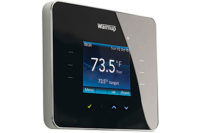Heat pumps lead in energy efficient trends
Technology advances in water heating realm.

Energy efficiency has become a priority for an increasing number of builders, contractors and engineers who work on and support green projects. In fact, sustainability and green solutions are becoming more than just a trend as cities and states across the country have implemented government policies to reduce energy use and greenhouse gas emissions from buildings. Not to mention the private company-directed sustainability initiatives that continue to gain popularity in the commercial space.
To align with these efforts and evolving greenhouse gas emission reduction policies, water heating manufacturers have begun to offer heat pump water heaters with advanced technology. When it comes to load management, app-based solutions are becoming more common in the residential sector, making it even easier to save energy and track cost savings. While there aren’t any regulatory drivers yet for load management or app-based resources in commercial applications, connectivity has started to gain popularity, as more customers want to see and track the energy used by certain appliances in the buildings they manage.
What’s driving efficiency?
Energy and environmental regulations, at the state and local levels, are influencing the adoption of energy-efficient appliances and building resources. When it comes to energy efficiency requirements, California’s building codes are some of the most progressive, but regulations are starting to spread across the country.
Industry professionals anticipate that most regions of the country will be impacted by stricter building codes and regulations soon, creating an even larger demand for energy-efficient technology. Initiatives, such as net-zero buildings, LEED certification and WELL building standards, all contribute to the increasing urgency for energy efficient, smart solutions in all aspects of the building industry.
Electrification and decarbonization also play an important role in energy efficiency. Reducing our dependence on fossil fuels and using electricity as the primary fuel source in buildings and homes cuts down on the carbon footprint and greenhouse gas emissions.
Additionally, more builders are installing smartphone-controlled appliances that help users save energy by optimizing their operation. This technology also gives facility managers and service professionals remote access to monitor and adjust as needed for a more efficient output.
Heat pump technology in water heaters
In the world of water heating, heat pump technology is at the forefront of energy efficiency. Heat pump technology is based on the principle that it’s more cost efficient to transfer heat from existing air or water, rather than create it with a fuel source. While there are both air and water source heat pumps, air is more popular and works by drawing in the heat and humidity from the air around the water heater, concentrating the heat and transferring it to the water in the tank. With this type of energy conversion, the savings benefits are substantial. Though heat pump water heaters often come with a higher upfront price tag, they cut operating costs by more than half, compared to a standard electric water heater.
Aside from significantly higher efficiency, there are two key differences between heat pump water heaters and standard electric water heaters. Heat pump water heaters will produce a non-acidic condensate during normal operation that must be drained. Since heat pump water heaters transfer heat from the air, they also need adequate air flow. This can be accomplished by installing the unit in a larger space (greater than 700 cubic feet) or providing additional air exchange through ducting or louvers to connect to an adjacent space.

A.O. Smith’s mobile app connects homeowners and service professionals with remote monitoring. Photo courtesy of A.O. Smith.
Making it easy with apps
Water heater manufacturers take things one step further by creating apps that provide enhanced connectivity. For example, A. O. Smith’s mobile app is available for homeowners and service professionals.
It provides personalized recommendations to help professionals identify the best option for their customer based on their individual needs. It also allows them to stay connected to the water heaters they install to provide remote monitoring and adjust temperatures and settings based on their customers’ needs and preferences.
Specific temperatures and operating modes can be set from a smart phone. Customers of utilities with time-of-use rates can further reduce their utility bill by having a heat pump water heater operate when electricity is least expensive.
Utilities can benefit from apps like this too with new demand response capabilities. Once the homeowner opts into the utility demand response program, the water heater can respond to schedules based on electricity prices or signals sent directly from the utility, allowing the water heater to be used as a grid asset and also helping to reduce utility bills.
The future of energy efficiency
Manufacturers continue to introduce more efficient options to the water heating industry, often relying on connectivity and IoT technology to make the product applicable in a variety of settings. A. O. Smith is working with utility companies across the country to establish incentive programs to help offset the upfront costs of heat pump water heating systems and make it easier for customers to choose eco-friendly options.
As our world moves toward more energy efficient choices, the water heating industry can help lead the way with research, customized solutions and support for building professionals. With heat pump water heaters, professionals can offer an option that is not only innovative and reliable, but one that also represents the future of energy efficiency for water heating.
Looking for a reprint of this article?
From high-res PDFs to custom plaques, order your copy today!




